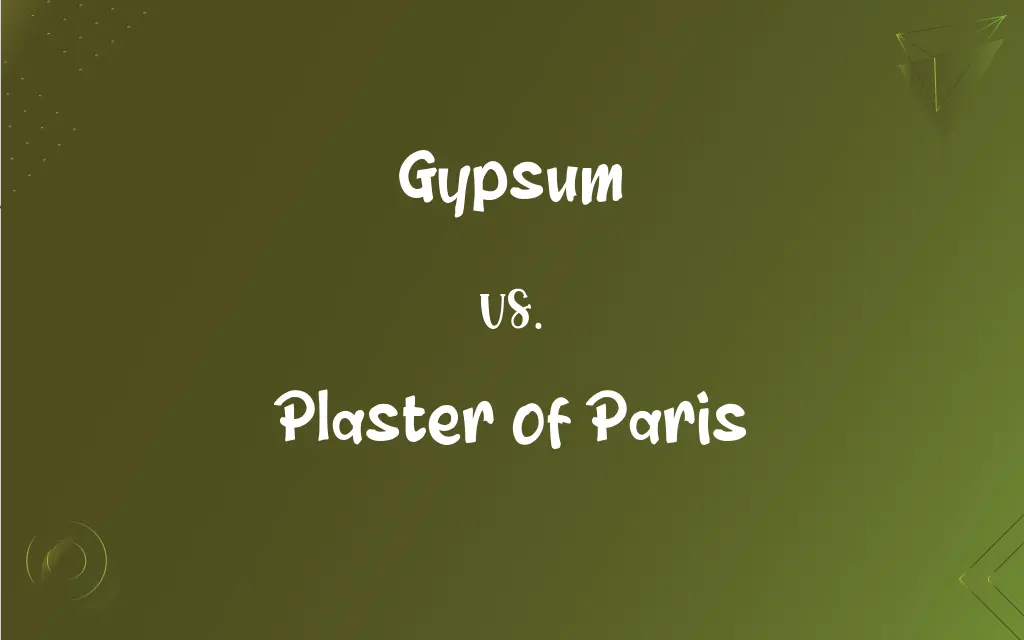Gypsum vs. Plaster of Paris: What's the Difference?
Edited by Aimie Carlson || By Janet White || Published on December 4, 2023
Gypsum is a mineral (calcium sulfate dihydrate) used in construction; Plaster of Paris is a quick-setting gypsum product used in mold making and casting.

Key Differences
Gypsum, naturally occurring as a mineral, is widely used in the construction industry for drywall and plaster products. Plaster of Paris, derived from gypsum, is a fine white powder used primarily for casting and molding.
Gypsum serves as a key ingredient in various building materials, providing fire resistance and sound insulation. Plaster of Paris, when mixed with water, sets quickly and is used for decorative elements, molds, and casts.
In its raw form, gypsum is a soft sulfate mineral known for its versatility in construction and agriculture. Plaster of Paris, on the other hand, is known for its ability to be molded into intricate shapes and its use in art and medical casts.
Gypsum acts as a soil conditioner in agriculture, improving soil structure and water infiltration. Plaster of Paris is renowned in the art world for creating detailed sculptures and in medicine for orthopedic casts.
Gypsum panels are widely used in building for creating walls and ceilings due to their durability. Plaster of Paris, with its fine texture and quick setting time, is ideal for making detailed architectural elements and repairs in buildings.
ADVERTISEMENT
Comparison Chart
Composition
Calcium sulfate dihydrate
Partially dehydrated gypsum
Primary Use
Construction material for drywall
Mold making and casts
Setting Time
Longer setting time
Quick setting upon mixing with water
Texture
Can be rough or smooth
Fine, smooth texture
Applications
Building materials, agriculture
Art, medical casts, repairs
ADVERTISEMENT
Gypsum and Plaster of Paris Definitions
Gypsum
A soft sulfate mineral used in construction and agriculture.
Gypsum boards are commonly used for interior walls.
Plaster of Paris
Commonly used in medicine for making orthopedic casts.
The broken arm was set in a Plaster of Paris cast.
Gypsum
A natural mineral essential for the production of plaster and drywall.
The new building utilized gypsum for its fire-resistant properties.
Plaster of Paris
A fine white powder that hardens when mixed with water.
Plaster of Paris was used to create a detailed ceiling design.
Gypsum
Calcium sulfate dihydrate, a key ingredient in cement.
The cement mixture included gypsum to control the setting time.
Plaster of Paris
Used for making decorative elements and intricate casts.
The restoration project involved Plaster of Paris for ornamental details.
Gypsum
A versatile material in construction for making drywall and plaster.
The construction team chose gypsum panels for the project.
Plaster of Paris
A material favored in art for its moldability and fine texture.
Plaster of Paris was the medium of choice for the art class.
Gypsum
A mineral used as a soil conditioner in agriculture.
Gypsum improved the drainage and texture of the clay soil.
Plaster of Paris
A quick-setting gypsum product used in mold making and casting.
The artist used Plaster of Paris for her sculpture.
Gypsum
A widespread colorless, white, or yellowish mineral, CaSO4·2H2O, used in the manufacture of plaster of Paris, various plaster products, and fertilizers.
Gypsum
A mineral consisting of hydrated calcium sulphate. When calcinated, it forms plaster of Paris.
Gypsum
A mineral consisting of the hydrous sulphate of lime (calcium). When calcined, it forms plaster of Paris. Selenite is a transparent, crystalline variety; alabaster, a fine, white, massive variety.
Gypsum
A common white or colorless mineral (hydrated calcium sulphate) used to make cements and plasters (especially plaster of Paris)
FAQs
Can gypsum be used in agriculture?
Yes, as a soil conditioner to improve soil quality.
How is Plaster of Paris made?
It's made by heating gypsum to a high temperature and then grinding it into a powder.
What are the main uses of Plaster of Paris?
For making molds, casts, and decorative elements.
What are the properties of gypsum?
It's fire-resistant, sound insulating, and can improve soil.
Is gypsum used in making cement?
Yes, it's a key ingredient in cement production.
Can Plaster of Paris be reused?
Once it sets, it cannot be remolded or reused.
Can Plaster of Paris be used for repairs?
Yes, it's often used for repairing walls and ceilings.
What is gypsum?
Gypsum is a soft mineral used in construction and agriculture.
Is gypsum fire-resistant?
Yes, it's commonly used for fire-resistant drywall.
Why is gypsum important in drywall?
It provides durability and fire resistance to drywall.
Can gypsum boards be used in ceilings?
Yes, they are often used for both walls and ceilings.
How is Plaster of Paris used in art?
For creating sculptures and decorative art pieces.
How quickly does Plaster of Paris set?
It sets quickly, typically in about 30 minutes.
Is Plaster of Paris suitable for outdoor use?
It's not typically recommended for outdoor use as it's not weather-resistant.
How long does a Plaster of Paris cast last?
It depends on the application but typically lasts until the bone heals.
Are gypsum panels easy to install?
Yes, they are widely used due to their ease of installation.
Does gypsum improve soil drainage?
Yes, it helps improve soil structure and drainage.
Is Plaster of Paris toxic?
No, it's generally considered non-toxic but should not be ingested.
How is gypsum mined?
It's typically mined from sedimentary rock formations.
Can Plaster of Paris be painted?
Yes, once dry, it can be easily painted or colored.
About Author
Written by
Janet WhiteJanet White has been an esteemed writer and blogger for Difference Wiki. Holding a Master's degree in Science and Medical Journalism from the prestigious Boston University, she has consistently demonstrated her expertise and passion for her field. When she's not immersed in her work, Janet relishes her time exercising, delving into a good book, and cherishing moments with friends and family.
Edited by
Aimie CarlsonAimie Carlson, holding a master's degree in English literature, is a fervent English language enthusiast. She lends her writing talents to Difference Wiki, a prominent website that specializes in comparisons, offering readers insightful analyses that both captivate and inform.































































